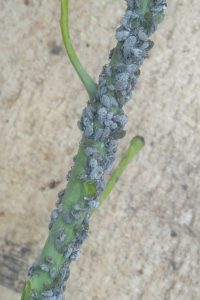Alameda Sun, Thursday, August 11, 2022
by Linda Carloni, Alameda Backyard Growers
 It’s a lovely warm summer day. The kale plants in the garden have looked lush and productive, ready for salads and sautés. The broccoli and chives have been doing well too. But suddenly — aphids! Aphids are small insects that have soft, pear-shaped bodies that can accumulate in large numbers and cause a lot of damage. Aphids pierce plant parts and suck out fluids. A few aphids aren’t damaging, but their numbers can explode rapidly. An adult aphid can produce up to 80 offspring in a week, and it takes about a week for an aphid nymph to grow into a reproducing adult. Green or gray (in varying shades) are the most common aphid colors on vegetables grown here.
It’s a lovely warm summer day. The kale plants in the garden have looked lush and productive, ready for salads and sautés. The broccoli and chives have been doing well too. But suddenly — aphids! Aphids are small insects that have soft, pear-shaped bodies that can accumulate in large numbers and cause a lot of damage. Aphids pierce plant parts and suck out fluids. A few aphids aren’t damaging, but their numbers can explode rapidly. An adult aphid can produce up to 80 offspring in a week, and it takes about a week for an aphid nymph to grow into a reproducing adult. Green or gray (in varying shades) are the most common aphid colors on vegetables grown here.
Many Alameda gardeners report summer aphids primarily on cole crops — kale, broccoli, Brussels sprouts, bok choy, and the like. The dark gray cabbage aphid attacks these. But other crops, including chives, squash, cucumbers, even tomatoes and carrots, can be attacked by other kinds of aphids. Aphids cause the most damage when temperatures are between 65ºF and 80º F. Further inland, where it is much hotter, aphid populations are reduced in the summer.
Management is pretty much the same for all aphids on vegetables. Monitoring is key. Look for the insects and eggs, for black smudgy sticky material on the plant, and for ants. This attracts ants, which then protect the aphids, so when a lot of ants are present, aphids are a good possibility.
If aphids are detected when there are only a moderate number and the bugs are accessible, a hose spray works wonders. Use a spray strong enough to wash the aphids all the way off, but not so strong as to damage the plant. Pay particular attention to the back of the leaves, and spray in the morning so the leaves can dry quickly. Most of the knocked-off aphids won’t be able to return to the plant. It is likely to take two or three sprays over several days to complete the project. Then keep monitoring.
Silver-colored reflective mulches also repel aphids. Silver-colored plastic sold in rolls will work, as does home-made silver spray-painted construction paper. I’ve used aluminum foil in pots too. Using the plastic mulch requires drip irrigation under the plastic. Make sure to bury the edges in the soil to hold the mulch down, and if it gets really hot the mulch should be removed.
If the plants are completely infested and the water spray and reflective mulch aren’t enough, insecticidal soaps and oils (neem or horticultural) may be effective. These kill mostly by smothering the aphid, so thorough application is critical. Be sure to follow the instructions on the package. These sprays kill only aphids (and, unfortunately, some beneficial insects) that are present on the day they are used, so applications may need to be repeated.
Prevention is the best route for managing aphids. Beneficial insects such as parasitic wasps, lady beetles and their larvae, soldier beetles, and the larvae of some insects all help manage aphids. Adult lady beetles can be purchased, but even if released carefully they tend to migrate away. Growing flowers that attract beneficial insects is the best bet. Many herbs will attract beneficial insects when left to flower, and penstemons, yarrow, buckwheats, ceanothus, and lavender also draw them. A good list of California native plants that attract pest-eating insects is here: https://ucanr.edu/blogs/blogcore/postdetail.cfm?postnum=22670 and a good overall list is here: https://ucanr.edu/blogs/blogcore/postdetail.cfm?postnum=16607.
Read the original article in the Alameda Sun here – and support our local newspaper by buying a subscription!
